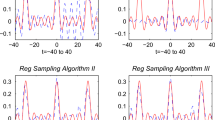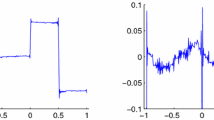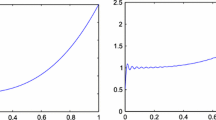Abstract
In this paper the ill-posedness of restoring lost samples is discussed in the two dimensional case. The restoration algorithm by Shannon’s Sampling Theorem is analyzed. A regularized restoring algorithm for two dimensional band-limited signals is presented. The convergence of the regularized restoring algorithm is studied and compared with the restoration algorithm by Shannon’s sampling theorem in the two dimensional case.

Similar content being viewed by others
References
Belge, M., Kilmer, M. E., & Miller, E. L. (2002). Efficient determination of multiple regularization parameters in a generalized L-curve framework. Inverse Problems, 18, 1161–1183.
Chen, W. (2006). An efficient method for an Ill-posed problem–band-limited extrapolation by regularization. IEEE Transactions on Signal Processing, 54, 4611–4618.
Chen, W. (2011). The Ill-posedness of restoring lost samples and regularized restoration for band-limited signals. Signal Processing, 91, 1315–1318.
Cheung, K. F., & Marks, II R. J. (May 1985). Ill-posed sampling theorems. IEEE Transactions on Circuits and Systems, vol. CAS-32, 481–484.
Eldar, Y. C., & Unser, M. (2006). Nonideal sampling and interpolation from noisy observations in shift-invariant spaces. IEEE Transactions on Signal Processing, 54(7).
Griesbaum, A., Barbara, B., & Vexler, B. (2008). Efficient computation of the Tikhonov regularization parameter by goal-oriented adaptive discretization. Inverse Problems, 24, 1–20.
Kilmer, M. E., & O’leary, D. P. (2001). Choosing regularization parameters in iterative methods for ill-posed problems. SIAM Journal on Matrix Analysis and Applications, 22(4), 1204–1221.
Marks II, R. J. (1983). Restoring lost samples from oversampled band-limited signal. IEEE Transactions on Signal Processing, ASSP-31, 752–755.
Marks, R. J, I. I. (1991). Introduction to shannon sampling and interpolation theory. New York: Springer.
Selva, J. (2009). Functionally weighted Lagrange interpolation of band-limited signals from nonuniform samples. IEEE Transactions on Signal Processing, 57, 168–181.
Shannon, C. E. (July 1948). A mathematical theory of communication. The Bell System Technical Journal, 27, 379–423.
Smale, S., & Zhou, D.-X. (2004). Shannon sampling and function reconstruction from point values. Journal: Bulletin of the American Mathematical Society, 41, 279–305.
Tikhonov, A. N., & Arsenin, V. Y. (1977). Solution of Ill-posed problems. Winston: Wiley.
Acknowledgments
The author would like to express appreciation to professor Malcolm R. Adams for his help in the revision of this paper.
Author information
Authors and Affiliations
Corresponding author
Appendix
Appendix
Proof of Theorem 1.2
In (1) we take the convolution with
we obtain
Let \(t_1=0, ~t_2=0\), solve for \(f(0, 0)\), then we obtain the formula (2).
Proof of Lemma 3.3
By the Cauchy inequality and Lemma 3.2
Proof of Lemma 3.4
By Lemma 3.1, the first two terms are of the order \(O(\delta )+O(\delta \ln \frac{1}{\alpha })\). By using the estimation (6) the third term is of the order \(O(\delta \ln ^2 \frac{1}{\alpha })\).
Proof of Lemma 3.5
By the Cauchy inequality
Then by Lemma 3.2, \(I^2=O(\alpha )\).
Proof of Lemma 3.6
By the Cauchy inequality
Then by Lemma 3.2, \(J_1^2=O(\alpha ^\frac{1}{2})\).
Proof of Lemma 3.7
\(J_2=I_1+I_2+I_3\) where
Here
by Lemma 3.3. For the same reason \(I_2=O(\alpha ^{\frac{1}{4}})\).
by Lemma 3.5 and by Lemma 3.6.
Proof of Theorem 3.1
\(f_\alpha (0, 0)-f_E(0, 0)\)
where \(J_2=O(\alpha ^{\frac{1}{4}})\) is the same as in Lemma 3.7 and
is the same as in Lemma 3.4.
Rights and permissions
About this article
Cite this article
Chen, W. Regularized restoration for two dimensional band-limited signals. Multidim Syst Sign Process 26, 665–675 (2015). https://doi.org/10.1007/s11045-013-0263-2
Received:
Revised:
Accepted:
Published:
Issue Date:
DOI: https://doi.org/10.1007/s11045-013-0263-2




